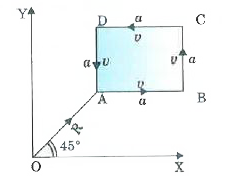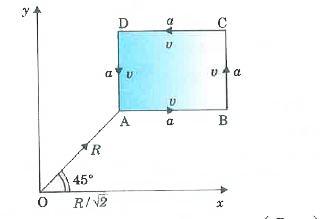A particle of mass of m is moving along the side of square of side 'a' with a uniform speed u in the X-Y plane as shown in the figure.

Which of the following statements is false for the angular momentum →L about the origin ?
→L=−mv√2Rˆk when the particle is moving from A to B.
→L=mv[(R√2−a]ˆk when the particle is moving from C to D.
→L=mv[(R√2+a]ˆk when the particle is moving from B to C.
→L=mv√2Rˆk when the particle is moving from D to A.
The correct Answer is:D
Angular momentum about point "O" is
→L=m(→r×→v)
=mrvsinθˆn
r is the perpendicular distance from axis of rotation to the velocity of particle.
We can find the direction of L by using method of cross product of vectors (right-hand rule) for each segment of square.

Along CD, distance from line of motion r r=(R√2+a)
∴→L=(R√2+a)mvˆk∴ option (b) is incorrect.
Moving along D to A, r=(R√2)butdirectionofLis∈¬ativeZaξs.<br>:.vecL=(R)/(sqrt2)mv(-hatk):. option (d) is incorrect.
Topper's Solved these Questions
- BOOK - MODERN PUBLICATIONCHAPTER - SYSTEMS OF PARTICLES AND ROTATIONAL MOTIONEXERCISE - COMPETITION FILE ( OBJECTIVE TYPE QUESTIONS MULTIPLE CHOICE QUESTIONS (with more than one correct answer) )35videos
SYSTEMS OF PARTICLES AND ROTATIONAL MOTION
- BOOK - MODERN PUBLICATIONCHAPTER - SYSTEMS OF PARTICLES AND ROTATIONAL MOTIONEXERCISE - COMPETITION FILE (OBJECTIVE TYPE QUESTIONS (ASSERTION REASON TYPE QUESTIONS) )10videos
SYSTEMS OF PARTICLES AND ROTATIONAL MOTION
- BOOK - MODERN PUBLICATIONCHAPTER - SYSTEMS OF PARTICLES AND ROTATIONAL MOTIONEXERCISE - COMPETITION FILE (OBJECTIVE TYPE QUESTIONS (MULTIPLE CHOICE QUESTIONS) (MULTIPLE CHOICE QUESTIONS WITH ONLY ONE CORRECT ANSWER) )67videos
SYSTEMS OF PARTICLES AND ROTATIONAL MOTION
- BOOK - MODERN PUBLICATIONCHAPTER - PHYSICAL WORLD EXERCISE - Revision exercises (Long answer questions)6videos
PHYSICAL WORLD
- BOOK - MODERN PUBLICATIONCHAPTER - THERMAL PROPERTIES OF MATTEREXERCISE - CHAPTER PRACTICE TEST15videos
THERMAL PROPERTIES OF MATTER
Similar Questions
Knowledge Check
- Question 1 - Select One or More
A particle of mass m is moving along the side of a square of side a, with a unifrom speed v in XY palne as shown in Fig. Which of the followig statements is false for the angualr momentum →L about the origin?
 A→L=−mv√2Rˆk, when particle is moving from A→BB→L=−(mv)(R√2−a)ˆk, when particle is moving from C→DC→L=−(mv)(R√2+a)ˆk, when particle is moving from B→CD→L=−mv√2Rˆk, when particle is moving from D→A
A→L=−mv√2Rˆk, when particle is moving from A→BB→L=−(mv)(R√2−a)ˆk, when particle is moving from C→DC→L=−(mv)(R√2+a)ˆk, when particle is moving from B→CD→L=−mv√2Rˆk, when particle is moving from D→A - Question 2 - Select One
A particle with the position vector r has linear momentum p. Which of the following statements is true is respect of its angular momentum L about the origin ?
AL acts along pBL acts along rCL is maximum when p and r are parallelDL is maximum when p is perpendicular to r - Question 3 - Select One
A particle with position vector has a linear momentum p. Which of the following statements is true in respect of its angular momentum L about the origin?
AL acts along pBL acts along rCL is maximum when p and r are parallel.DL is maximum when p is perpendicular to r.
A particle of mass m=5 unit is moving with a uniform speed v=3√2 unit in the XOY plane along the line y=x+4 the magnitude of the angular momentum of the particle about the origin is
View SolutionA particle of mass m=5 unit is moving with a uniform speed v=3√2 unit in the XOY plane along the line y=x+4 the magnitude of the angular momentum of the particle about the origin is
View SolutionA particle of mass m = 5 units is moving with a uniform speed v=3√2 units in the XOY plane along the line Y = X + 4. The magnitude of the angular momentum of the particle about the origin is
View SolutionA particle of mass m=5kg is moving with a uniform speed v=3√2 in the XOY plane along the line Y=X+4. The magnitude of the angular momentum of the particle about the origin is
View SolutionA particle of mass m=5kg is moving with a uniform speed v=3√2 in the XOY plane along the line Y=X+4. The magnitude of the angular momentum of the particle about the origin is
View Solution

